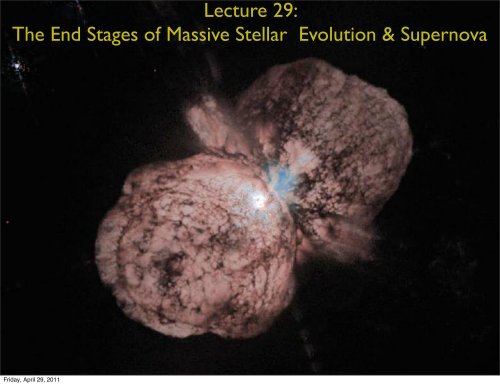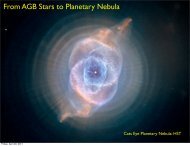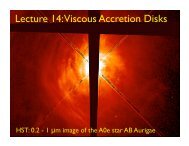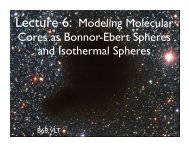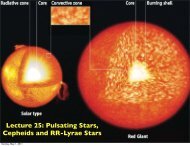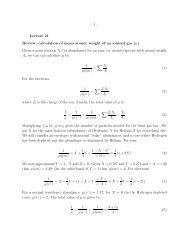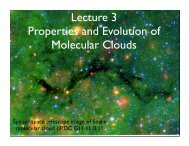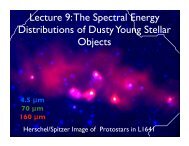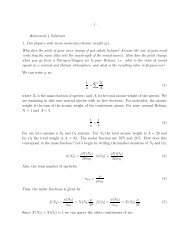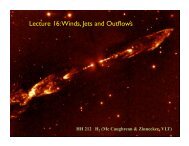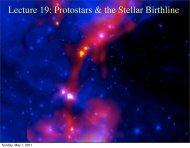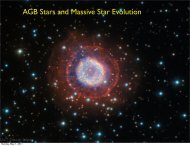Lecture 29: The End Stages of Massive Stars and Supernovae
Lecture 29: The End Stages of Massive Stars and Supernovae
Lecture 29: The End Stages of Massive Stars and Supernovae
You also want an ePaper? Increase the reach of your titles
YUMPU automatically turns print PDFs into web optimized ePapers that Google loves.
<strong>Lecture</strong> <strong>29</strong>:<br />
<strong>The</strong> <strong>End</strong> <strong>Stages</strong> <strong>of</strong> <strong>Massive</strong> Stellar Evolution & Supernova<br />
Friday, April <strong>29</strong>, 2011
Review: Elemental Abundances in the Solar System<br />
Friday, April <strong>29</strong>, 2011
Review: Elemental Abundances in the Solar System<br />
Synthesized by S <strong>and</strong> R-processes<br />
Friday, April <strong>29</strong>, 2011
Review: Elemental Abundances in the Solar System<br />
Synthesized by S <strong>and</strong> R-processes<br />
What causes all the structure?<br />
Friday, April <strong>29</strong>, 2011
Dominant Elements in Nuclear Statistical Equilibrium<br />
Clayton<br />
Friday, April <strong>29</strong>, 2011
the s-process<br />
Clayton<br />
<strong>The</strong> s-processes produces stable nuclei where Z ~ N<br />
Friday, April <strong>29</strong>, 2011
Cross Section to Neutron Capture<br />
Clayton<br />
Friday, April <strong>29</strong>, 2011
s-process abundances<br />
Seegar, Fowler & Clayton 1965<br />
<strong>The</strong> points are the neutron cross-section x the solar system abundance. This<br />
varies smoothly with atomic weight. <strong>The</strong> line is the theoretical prediction<br />
calculated assuming an exponential distribution <strong>of</strong> neutron exposures.<br />
Friday, April <strong>29</strong>, 2011
the s <strong>and</strong> r-processes<br />
Seegar, Fowler & Clayton 1965<br />
Friday, April <strong>29</strong>, 2011
the r-process elements<br />
Clayton<br />
<strong>The</strong> r-process elements are created when the neutron<br />
rich elements undergo beta decay.<br />
Friday, April <strong>29</strong>, 2011
Seegar, Fowler & Clayton 1965<br />
the r-process<br />
<strong>The</strong> peaks are more stable elements that would appear in<br />
greater abundance as the r-process cycles through<br />
elements.<br />
Friday, April <strong>29</strong>, 2011
the r-process predicted abundances<br />
Seegar, Fowler & Clayton 1965<br />
As the r-process cycles through the elements (every 5 seconds in the above models), the<br />
above abundance distribution will be established. <strong>The</strong> abundances will double every cycle.<br />
Peaks are due to stable nuclei.<br />
Friday, April <strong>29</strong>, 2011
-process abundances<br />
Seegar, Fowler & Clayton 1965<br />
<strong>The</strong>se are R-process abundances after the subtraction <strong>of</strong> the S-process abundances<br />
Friday, April <strong>29</strong>, 2011
<strong>Massive</strong> Star Evolution<br />
Maeder et al. 1990 A&AS 84, 139<br />
Friday, April <strong>29</strong>, 2011
WN: HeII <strong>and</strong> N lines<br />
WNha: HeII, N <strong>and</strong> H lines<br />
WC & WO: HeII, C <strong>and</strong><br />
O lines<br />
Wolf Rayet <strong>Stars</strong>: <strong>Massive</strong> Blue<br />
<strong>Stars</strong> with Strong Line Emission<br />
Friday, April <strong>29</strong>, 2011<br />
Crowther et al. 2007
Luminous Blue Variables<br />
Humphrey & Davidson 1994<br />
Friday, April <strong>29</strong>, 2011
Luminous Blue Variables<br />
Humphrey & Davidson 1994<br />
Friday, April <strong>29</strong>, 2011
Luminous Blue Variables, Hypergiants, <strong>and</strong> Red Supergiants<br />
Humphrey-Davidson limit<br />
Friday, April <strong>29</strong>, 2011<br />
Humphrey & Davidson 1994
Evolution <strong>of</strong> Central Temperatures <strong>and</strong> Densites<br />
Asymmetrical Eruptions<br />
Friday, April <strong>29</strong>, 2011<br />
Woosley <strong>and</strong> Janka 2005
Elemental Abundances Before a Supernova<br />
Woosley, Heager & Weaver 2002<br />
Friday, April <strong>29</strong>, 2011
Core Collapse<br />
Infall velocity in presupernova<br />
Driven by pressure drops due to<br />
loss <strong>of</strong> energy by neutrinos,<br />
photodisintegration <strong>and</strong> capture <strong>of</strong><br />
e - by protons, core contracts.<br />
Mass exceeds the Ch<strong>and</strong>resekhar<br />
mass.<br />
Velocities reach about 1/4 c<br />
Collapse from size <strong>of</strong> Earth to 30<br />
km in<br />
~ 1 s<br />
Collapse stops when density<br />
approach 4-5x10 14 gm cm -3 <strong>and</strong><br />
nuclear repulsion forces become<br />
dominant.<br />
Woosley, Heager & Weaver 2002<br />
Friday, April <strong>29</strong>, 2011
<strong>The</strong> Bounce<br />
<strong>The</strong> abrupt stop <strong>of</strong> collapse<br />
(by nuclear repulsive forces)<br />
creates a bounce.<br />
Bounce stalls quickly due to<br />
energy losses (neutrinos <strong>and</strong><br />
photodisintegration).<br />
After bounce, core accreting<br />
matter at a few solar masses<br />
per second. If this last for<br />
even one second, core would<br />
collapse into black hole.<br />
Woosley, Heager & Weaver 2002<br />
Friday, April <strong>29</strong>, 2011
Neutrinos<br />
Neutrinos detected from SN 1987a<br />
1.Nearly massless<br />
2.Spin 1/2 (Lepton)<br />
3.Produced in β Decay (proposed to explain energy loss<br />
during decay)<br />
4.Interact only through the weak force, hence they can<br />
readily travel through matter at nearly the speed <strong>of</strong><br />
light<br />
Neutrinos Losses <strong>and</strong> Heating<br />
Neutrinos are produced during nuclear burning.<br />
As temperatures approach a billion K, a population <strong>of</strong> thermalized positions <strong>and</strong> electon pairs are<br />
created. <strong>The</strong>se can annihilate <strong>and</strong> sometimes produce neutrino/antineutrion pairs.<br />
e + + e - =>γ => ν + ν*<br />
<strong>The</strong>se can escape, leading to major source <strong>of</strong> energy. Also, during core collapse,<br />
p + e - => n + ν<br />
During core collapse, 10% <strong>of</strong> the rest mass is emitted in neutrinos, about 3 x 10 53 ergs in a few<br />
seconds. This stops accretion <strong>and</strong> prevents the core from becoming a black hole.<br />
About 1-2 x 10 51 ergs is then converted into kinetic energy through neutrino heating<br />
Friday, April <strong>29</strong>, 2011
Neutrinos Losses<br />
Friday, April <strong>29</strong>, 2011<br />
Woosley <strong>and</strong> Janka 2005
Neutrinos Heating<br />
Neutrinos are absorbed by the<br />
reactions:<br />
p + ν => n + e +<br />
n + ν => p + e -<br />
Text<br />
This inflaces bubble <strong>of</strong> photons<br />
<strong>and</strong> electron positron pairs<br />
which drives explosion.<br />
This hot gas is convectively<br />
unstable.<br />
Friday, April <strong>29</strong>, 2011<br />
Woosley <strong>and</strong> Janka 2005
From Bounce to Explosion<br />
Friday, April <strong>29</strong>, 2011
From Bounce to Explosion<br />
Burrows et al. 1995<br />
Friday, April <strong>29</strong>, 2011
<strong>The</strong> Explosion<br />
Buoyant bubbles<br />
push outward,<br />
creating shock<br />
waves as they rise.<br />
<strong>The</strong> snapshots are<br />
for sizes <strong>of</strong> <strong>of</strong> 200,<br />
300, 500 <strong>and</strong> 2000<br />
km s -1<br />
Note the turbulent,<br />
bubbling<br />
morphology.<br />
Woosley <strong>and</strong> Janka 2005<br />
Friday, April <strong>29</strong>, 2011
<strong>The</strong> Explosion<br />
Woosley, Heager & Weaver 2002<br />
Friday, April <strong>29</strong>, 2011
<strong>The</strong> Explosion<br />
Turbulences mixes<br />
elements from<br />
different layers<br />
Woosley <strong>and</strong> Janka 2005<br />
Friday, April <strong>29</strong>, 2011
<strong>The</strong> Explosion<br />
Woosley, Heager & Weaver 2002<br />
Friday, April <strong>29</strong>, 2011
<strong>The</strong> Jet<br />
Neutrons stars can have velocities <strong>of</strong> 300-400 kms -1 , sometimes as high as 1000 km s -1 .<br />
This may be driven by asymmetries in the inner motions due to convection.<br />
Pair Instability Supernova<br />
Friday, April <strong>29</strong>, 2011<br />
Woosley <strong>and</strong> Janka 2005
<strong>The</strong> Neutrino<br />
Driven<br />
Neutron Wind<br />
Antineutrinos captured by<br />
protons create neutron<br />
wind for about 10 seconds<br />
As exp<strong>and</strong>ing gas coolse,<br />
these particles combine<br />
with protons to creates<br />
alpha particle<br />
Further cooling results in<br />
seed nuclei<br />
<strong>The</strong>n wind then drives the<br />
r-process<br />
Woosley <strong>and</strong><br />
Janka 2005<br />
Friday, April <strong>29</strong>, 2011
What<br />
Kind <strong>of</strong><br />
Remnant?<br />
Also - pair<br />
instability<br />
SN may<br />
have no<br />
remnant.<br />
Woosley, Heager & Weaver 2002<br />
Friday, April <strong>29</strong>, 2011
Observations: Types <strong>of</strong> Supernova<br />
Type I: No Hydrogen lines<br />
Type Ia: Lack Hydrogen <strong>and</strong> Si II near light peak<br />
Due to Collapse <strong>and</strong> detonation <strong>of</strong> white dwarf after it exceeds Ch<strong>and</strong>rasekhar limit (by<br />
accreting gas or merger)<br />
Type Ib: Non-ionized He <strong>and</strong> no SiII<br />
Probably due to the core collapse <strong>of</strong> massive star.<br />
Type Ic: Weak He <strong>and</strong> no SiII<br />
Probably due to the core collapse <strong>of</strong> massive star.<br />
Type II: Hydrogen lines - core collapse <strong>of</strong> massive star.<br />
Friday, April <strong>29</strong>, 2011<br />
Crowther et al. 2007
Types <strong>of</strong> Supernova<br />
Friday, April <strong>29</strong>, 2011
Light Curves <strong>of</strong> Core Collapse Supernova<br />
Tail <strong>of</strong> light curve powered by radioactive decay.<br />
Woosley, Heager & Weaver 2002<br />
Friday, April <strong>29</strong>, 2011
Friday, April <strong>29</strong>, 2011<br />
Supernova 1987a
Friday, April <strong>29</strong>, 2011
Friday, April <strong>29</strong>, 2011
A Scenario for the<br />
necklace around SN<br />
1987a<br />
Friday, April <strong>29</strong>, 2011
Ch<strong>and</strong>ra,<br />
spitzer <strong>and</strong> HST<br />
3.4 kpc distant<br />
Exploded in 1681 +/- 19 years<br />
Friday, April <strong>29</strong>, 2011
Light Echoes<br />
From Sugerman et al. (2005) ApJSS, 159, 60<br />
Credit: NASA/JPL-Caltech/R. Hurt (SSC)<br />
Friday, April <strong>29</strong>, 2011
Light Echoes<br />
From Sugerman et al. (2005) ApJSS, 159, 60<br />
Credit: NASA/JPL-Caltech/R. Hurt (SSC)<br />
Krause, 2008<br />
Friday, April <strong>29</strong>, 2011
Cassiopeia A<br />
100<br />
50<br />
[ArII]<br />
[ArIII]<br />
[SIV]<br />
in multiple lines.<br />
0<br />
-50<br />
First detection<br />
-100<br />
6.99µm [-0.50,105.0]<br />
8.99µm [-0.60,14.0]<br />
10.51µm [-0.50,8.0]<br />
<strong>of</strong> “unshocked”<br />
100<br />
[NeII]<br />
[NeV]<br />
[NeIII]<br />
ejecta as well as<br />
50<br />
many elements<br />
0<br />
-50<br />
in shocked gas.<br />
(arcsec)<br />
-100<br />
100<br />
12.81µm [-0.20,12.0]<br />
[FeII]<br />
14.32µm [-0.40,2.5]<br />
[SIII]<br />
15.56µm [-0.10,4.0]<br />
[OIV]+[FeII]<br />
50<br />
0<br />
-50<br />
-100<br />
17.94µm [-0.50,2.0]<br />
18.71µm [-0.10,8.5]<br />
25.94µm [-0.10,19.0]<br />
100<br />
[SIII]<br />
[SiII]<br />
100 50 0 -50 -100<br />
50<br />
0<br />
-50<br />
Smith, 2009<br />
-100<br />
33.48µm [-0.02,3.5]<br />
34.81µm [-0.15,11.0]<br />
100 50 0 -50 -100<br />
100 50 0 -50 -100<br />
(arcsec)<br />
Friday, April <strong>29</strong>, 2011
Friday, April <strong>29</strong>, 2011
Friday, April <strong>29</strong>, 2011<br />
Cas A In 3D!
We discussed s <strong>and</strong> r-process: s-process produces stable isotopes (N ~ Z), r-process produces neutron rich isotopes that may decay to more<br />
stable isotopes. In s process, abundances are modulated by cross section. In r process, they are modulated by decay times (<strong>and</strong> stability <strong>of</strong> nuclei).<br />
Both tend to peak toward magic number nuclei (nuclei with closed shells for nucleons).<br />
Wolf Rayet <strong>Stars</strong> are massive stars with bright Helium emission lines, <strong>and</strong> <strong>of</strong>ten bright Carbon, Nitrogen <strong>and</strong>/or Oxygen emission lines that form in<br />
winds. Hydrogen is usually absent.<br />
Luminous Blue Variables (LBV) are undergoing large eruptions, may be intermediate state between Red Supergiants <strong>and</strong> Wolf Rayet <strong>Stars</strong> (or not).<br />
Summary<br />
<strong>Massive</strong> stars in these stages undergo supernova when their iron core collapses. <strong>The</strong> core loses energy due to the photodisintegration <strong>of</strong> iron <strong>and</strong><br />
nickel <strong>and</strong> energy losses from neutrinos. <strong>The</strong> mass exceeds the Ch<strong>and</strong>rasekhar mass.<br />
<strong>The</strong> iron core collapses until nuclear repulsion stops the contraction. A bounce occurs, but this does not drive the supernova.<br />
<strong>The</strong> proto-neutron star then loses 10% <strong>of</strong> its mass in a neutrino wind (that releases 10 53 erg)<br />
<strong>The</strong> neutrino wind heats the surrounding gas. <strong>The</strong> ensuing convection drives shocks into the surrounding gas <strong>and</strong> the supernova explosion.<br />
A neutron wind driven by the neutrinos creates the r-process.<br />
Observational properties <strong>of</strong> supernova were reviewed.<br />
Type II supernova show hydrogen lines: they are core collapse.<br />
Type Ia supernova show no hydrogen lines <strong>and</strong> SiII absorption. <strong>The</strong>y are thought to be white dwarf supernova.<br />
Type Ib <strong>and</strong> Ic also show no Hydrogen lines. <strong>The</strong>se are probably core collapse supernvoa that lost their hydrogen rich envelopes in a wind.<br />
Supernova remnants interact with material ejected by the star earlier (SN 1987a)<br />
Supernova remants show spatially different distributions for different elements (example: Cass A)<br />
Friday, April <strong>29</strong>, 2011


